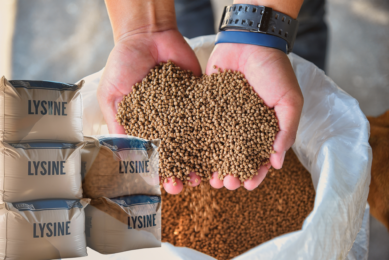Study: Optimum amino acid evaluation in rabbit feed

Researchers in Spain studied a wide range of ingredients to determine the best amino acid evaluation for rabbit feed formulation. They carried out a studied comparing ileal and faecal amino acid digestibility in concentrates and fibrous sources for rabbit feed formulation.
A semi-synthetic casein basal diet was designed for measuring the protein and amino acid endogenous flow. Another 11 diets, one for each ingredient (soybean meal, toasted full-fat soybean, soybean hulls, two types of sunflower meal (280 and 360g/kg CP), peas, alfalfa meal, wheat, wheat shorts, maize, and corn gluten feed), were formulated in order to get the maximal proportion of the protein from the tested feedstuffs studied maintaining the chemical composition and dietary nitrogen endogenous flow.
Ytterbium linked to fibre was used as a marker (4g/kg). Twenty-eight New Zealand White×Californian doe rabbits fitted with a glass T-cannula at the ileum were fed the experimental diets ad libitum for 16 d (for 6 periods each). Feed intake and hard faeces excretion were recorded for each rabbit over a 4-d period (10–15 d).
On days 15 and 16, ileal samples from each rabbit were collected under gravity for 1h from 19:00 to 23:00h to avoid the effect of the soft faeces excretion period on the protein ileal flow. The endogenous ileal flow of N was 512mg/d as average and increased 6mg/g of DMI (P<0.001). Amino acids ileal endogenous flow varied from 399mg/d for glutamic acid to 26mg/d for methionine.
Soybean meal and full-fat showed high (>0.90) and similar (P>0.05) apparent faecal (AF) and true ileal (TI) N and amino acids digestibility, whereas those of soybean hulls were lower (0.653 and 0.529 for AF and TI N digestibility, respectively). Cereals and their by-products showed the highest differences between AF and TI N and amino acids digestibility, because they were well digested at ileal level (ranged from 0.809 to 0.880), whereas AF digestibility was lower (from 0.630 to 0.769). Likewise, sunflower meals, peas and alfalfa showed higher TI than AF digestibility, but this difference was only relevant (from 0.052 to 0.16 units) for some amino acids (Thr, Val, Ile, Leu, Lys, and Ala).
The current work shows that the relative value among ingredients change depending on the digestibility unit used, and confirms that TI digestibility is the recommendable unit for feed formulation in rabbits.
For more information on this study see Animal Feed Science and Technology











